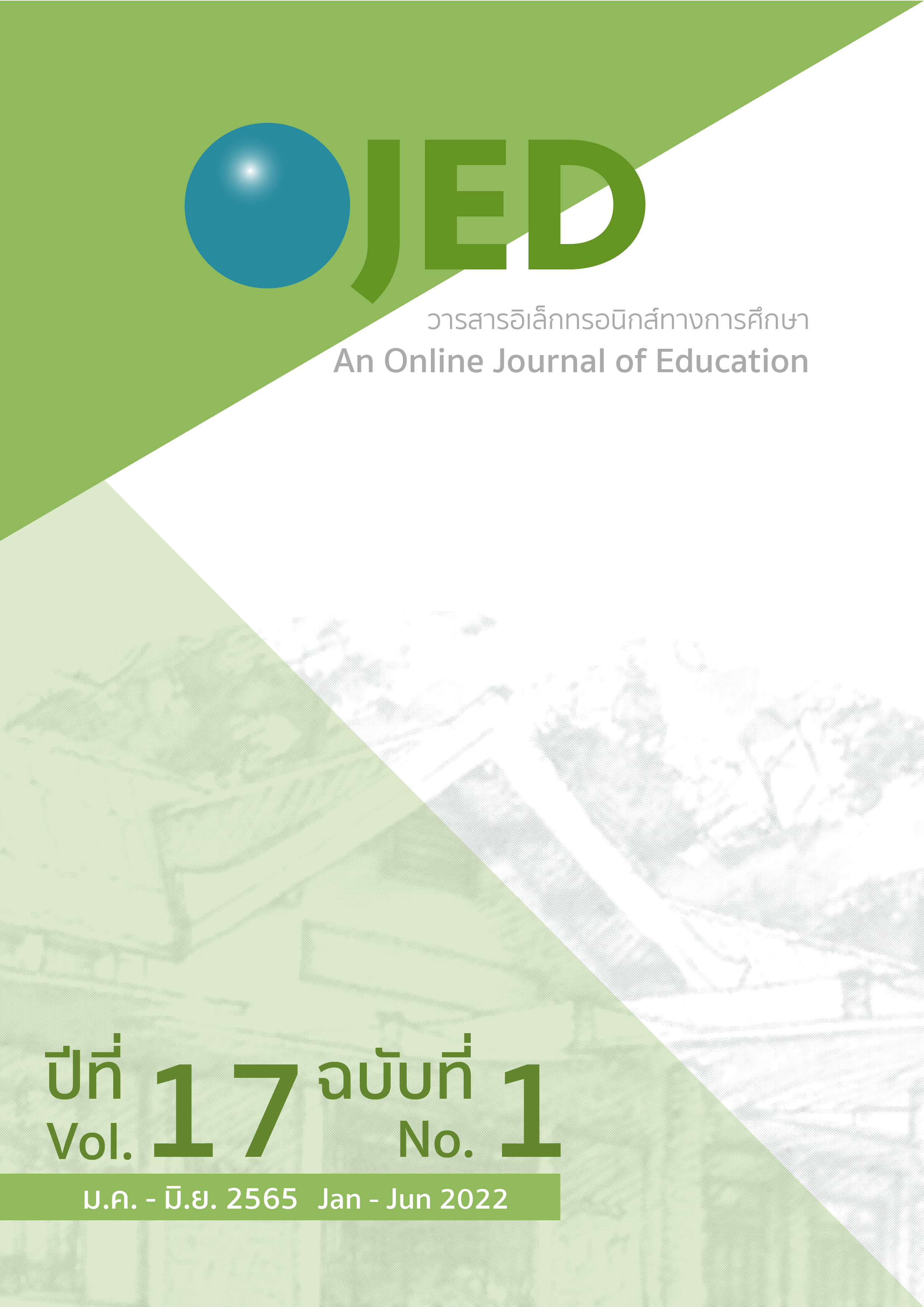Integrated STEAM Education Learning Provision for Developing Design Thinking of Young Children
DOI:
https://doi.org/10.14456/ojed.2022.1Keywords:
integrated steam education learning provision, design thinking, early childhoodAbstract
The purpose of this study was to study the effects of using an integrated STEAM Education provision for developing the design thinking of young children. The target group consisted of fifteen boys and fifteen girls at kindergarten level in a demonstration school in Bangkok, and the study was conducted for six weeks during the 2019 academic year. The six tools used for this included integrated STEAM Education lesson plans and an assessment form measuring the design thinking of young children. Data were analyzed through mean, median, and content analysis. The results revealed that young children who participated in the program showed consistent development at design thinking, both holistically and in five key areas. Improved design thinking includes the following steps: Step 1) Empathy: children began to understand the cause-result relationship, leading to increased problem identification ability, with an average score of 4.00. Step 2) Definition: children could identity what they needed to solve problems and how to solve them, with an average score of 4.00. Step 3) Ideation: children could determine the materials for their invention as well as justify their decisions, with an average score of 4.00. Step 4) Work creation: children could use the selected materials along with design models to create an invention in the given time period. 5) Testing: most children could make inventions allowed by their designs, follow the required conditions and improve their work. The average score was 4.83
References
กระทรวงศึกษาธิการ. (2560). หลักสูตรการศึกษาปฐมวัย พุทธศักราช 2560. สำนักวิชาการและมาตรฐานการศึกษาสำนักงานคณะกรรมการการศึกษาขั้นพื้นฐาน กระทรวงศึกษาธิการ.
เจษฎา จำปาเงิน. (2561). ความหมายของสตีมศึกษา. https://www.gotoknow.org/posts/615148/
ฉัตรทราวดี บุญถนอม และ อรพรรณ บุตรกตัญญู. (2558). การจัดประสบการณ์บูรณาการการเรียนรู้สตีมศึกษาโดยการใช้วรรณกรรมเป็นฐานเพื่อพัฒนาความคิดสร้างสรรค์ของเด็กปฐมวัย. วารสารศึกษาศาสตร์ปริทัศน์, 30(3), 186-195.
ณัฐจรีย์ มีชัย ไทกล้า หมายเจริญ และ รัชฎาภรณ์ แทนปั้น. (2017). Design thinking วิธีแก้ปัญหาของนักคิดรุ่นจิ๋ว. https://web.tcdc.or.th/th/Articles/Detail/Design-Thinking
พรสุดา เพ็ชรเลิศ และ ปิยะนันท์ หิรัญชยโลทร. (2560). การจัดประสบการณ์บูรณาการการเรียนรู้สตีมศึกษาโดยการใช้วรรณกรรมเป็นฐานเพื่อพัฒนาความคิดสร้างสรรค์ของเด็กปฐมวัย. วารสารศึกษาศาสตร์ปริทัศน์, 30(3), 186-195.
มีนกาญจน์ แจ่มพงษ์. (2559). การพัฒนาชุดฝึกทักษะแบบสตีมศึกษาโดยการสร้างสรรค์ชิ้นงาน เรื่อง พลังงานรอบตัวเรา [วิทยานิพนธ์ปริญญามหาบัณฑิต ไม่ได้ตีพิมพ์]. มหาวิทยาลัยเทคโนโลยีราชมงคลธัญบุรี.
วิสูตร โพธิ์เงิน. (2560). Steam ศิลปะเพื่อนสะเต็มศึกษา: การพัฒนาการรับรู้ความสามารถและแรงบันดาลใจให้เด็ก. วารสารครุศาสตร์, 45(1), 302-334
วาทินี บรรจง. (2556). ผลของการจัดประสบการณ์ศิลปะโดยบูรณาการแนวคิดเชิงออกแบบที่มีต่อความคิดสร้างสรรค์ของเด็กอนุบาล [วิทยานิพนธ์ปริญญามหาบัณฑิต ไม่ได้ตีพิมพ์]. จุฬาลงกรณ์มหาวิทยาลัย.
ไปรมา อิศรเสนา ณ อยุธยา และ ชูจิต ตรีรัตนพันธ. (2560). Design Thinking: Learning by Doing การคิดเชิงออกแบบ : เรียนรู้ด้วยการลงมือกระทำ. http://resource.tcdc.or.th/ebook/Design
พรพิไล เลิศวิชา และ อัครภูมิ จารุกร. (2550). ออกแบบกระบวนการเรียนรู้โดยเข้าใจสมอง. ด่านสุทธาการพิมพ์.
ศูนย์พัฒนากลยุทธ์ทางธุรกิจ. (2561). Innovation & Business Design Thinking. https://www.sbdc.co.th/public-training-calendar/517/innovation-amp-business-design-thinking/
สํานักงานเลขาธิการสภาการศึกษา กระทรวงศึกษาธิการ. (2561). มาตรฐานการศึกษาของชาติ พ.ศ. 2561. สำนักงานเลขาธิการสภาการศึกษา กระทรวงศึกษาธิการ พ.ศ. 2561.
สถานบันส่งเสริมการสอนวิทยาศาสตร์และเทคโนโลยี. (2556). คู่มือการใช้หลักสูตรสาระการออกแบบและเทคโนโลยี (หลักสูตรอนาคต).http://www.ipst.ac.th/files/curriculum2556/ManualDesignTechnology.pdf
หทัยภัทร ไกรวรรณ. (2559). การจัดประสบการณ์การเรียนรู้แบบสตีมศึกษาที่มีต่อความสามารถในการแก้ปัญหาอย่างสร้างสรรค์ของเด็กปฐมวัย [วิทยานิพนธ์ปริญญามหาบัณฑิต ไม่ได้ตีพิมพ์]. มหาวิทยาลัยเกษตรศาสตร์.
Bruner, J. S. (1966). Toward a Theory of Instruction. Public Health Service.
Piaget, J. (1969). The Psychology of the child Translated by Halen Weaver. Basic Book.
Vygotsky, L. S. (1995). Mind in Society: The Development of Higher Psychological Processes. In M. Cole. V.
John Steiner.S. Scribner and E. Suberman (n.d.). The Development of
Higher Psychological Processes. Haward University Press.
Downloads
Published
How to Cite
Issue
Section
License
Copyright (c) 2022 An Online Journal of Education

This work is licensed under a Creative Commons Attribution-NonCommercial-NoDerivatives 4.0 International License.




